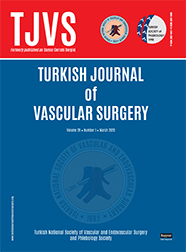
The Turkish Journal of Vascular Surgery
Yazarlar: Yusuf Kalko, Kenan Sever, Murat Başaran, Ufuk Alpagut, Emin Tireli, Emre Çamcı, Enver Dayıoğlu, Aydın Kargı
Konular:-
Anahtar Kelimeler:Acute type B dissections,Surgicaltreatment
Özet: The morbidity and mortality rates in acute type B dissections remain stili higher than in acute type A dissections . The controversies that stili continue concerning the optimal mode of treatment for uncomplicated type B dissections limi ted the number of cases managed surgically. At our institution, between January 1996-November 2000, we performed surgical intervention to 10 of 15 patients who had the diagnosis of an acute type B dissecting aortic aneurysm. Primary indications tor surgery were the presence of continued pain despite the medical treatment in 5 patients, large aneursms in 2 patients ( in one patient the diame ter of the aorta was 6 cm, in the other patient with the diagnosis of Marfan 's syndrome the diameter was 5 cm), pe ripheric and visceral organ malperfusion in 2 patients and uncontrollable hypertension in the last patient. Five pati ents without any problem were managed medically. Mortality rate was % 20. The first patient was lost at the end of postoperative day 30 because ofa new bleeding. The other patient was lost because of multiorgan failure at the end of postoperative day 25th. in one of the remaning patient, we observed a transient monoparesis . The most important concept in thoracic aortic surgery is the reperfusion injury of the vital organs including the spinal cord. in order to prevent the post-operative catastrophic complications related to reperfusion injury, many authors proposed the use of a distal perfusion technique especially in operations with cross-clamp times exceeding 45 mi nutes. in cases with severely calcified aortic wall and also in patients with a tear in aortic arch, the surgeon may ne ed the establishment of total circulatory arrest. Among several methods proposed for distal perfusion, partial femoro femoral cardiopulmonary bypass has the advantage of immediate establishment of total circulatory arrest. So, we believe that the partial femoro-femoral cardiopulmonary by-pass is the succesfull method that may be used in the surgical management of type B dissections.